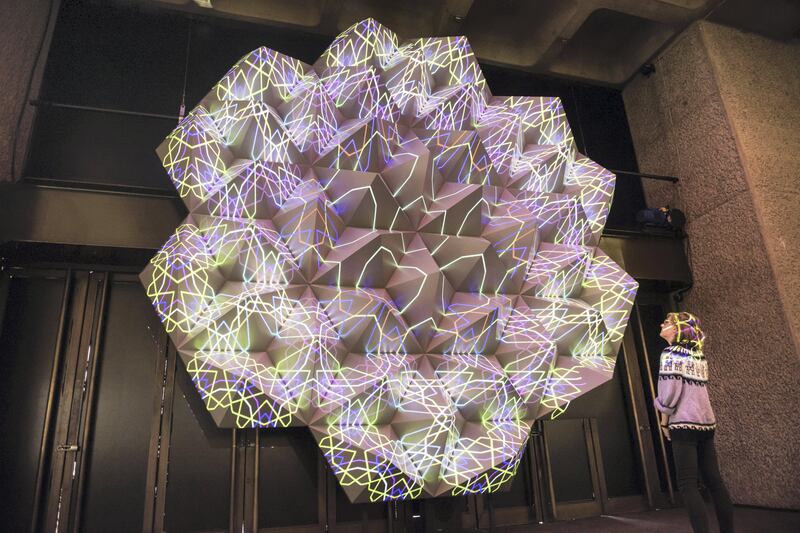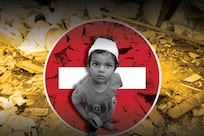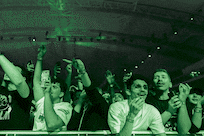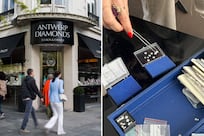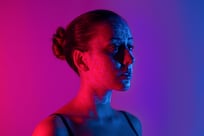If all goes well, September 1 will be a day that gives Zarah Hussain reason to celebrate.
An artist whose work combines the traditions of Islamic geometrical design with the very latest digital technology, Hussain discovered at the end of July that one of her installations, Numina, had been selected for the Lumen Prize longlist.
An international award that celebrates and promotes digital art and creativity, the Lumen Prize recognises projects that occupy a space where art, research and technology meet, which seems like a pretty good fit for Hussain’s work, sitting as it does at the intersection of science and spirituality, drawing and coding.
This year’s longlist will become a shortlist on September 1 and the winners across 12 categories will then be announced on September 20 in London before embarking on an exhibition tour that will include the Brighton Digital Festival, London’s Winter Lights Festival and Cyberfest 11 in St Petersburg, Russia.
Numina is one of 11 projects competing in the prize’s 3D/sculpture award category alongside projects such as The Storm by Ithaca, an interactive, LED-filled cloud and Seb Lee-Delisle’s The Mindfulness Machine, a robot that makes doodles that are determined by external stimuli such as the number of people watching it, the temperature, the weather, and its own virtual biorhythms.
Despite longlisting 93 projects from across the world for the 2017 Lumen Prize, Hussain’s is the only one to relate to the tradition and culture of Islam.
Numina was commissioned by The Barbican Centre in London to accompany its 2016 Transcender season of ecstatic, hypnotic and devotional music, which included performances in the spirit of the Sufi poet Rumi, featuring the Iranian female singer Parissa and the Meshk Ensemble, a group of Turkish dervishes, as well as an evening of Moroccan music from the Master Musicians of Jajouka led by Bachir Attar and the young vocal virtuoso, Marouane Hajji.
Hussain's response was to create a tessellating sculpture that measured about 9 metres by 7 metres and combines this with a looping and morphing digital laser projection and a sound installation composed by students from the nearby Guildhall School of Music and Drama.
Numina was exhibited in The Barbican's foyer between October last year and January this year .
“The Barbican wanted to transform the space so that no matter what you were doing there you would have an artistic experience one way or the other,” Hussain tells me, speaking from London.
“They had absolute faith in me, which from an artist’s point of view was an amazing experience. They said ‘come up with your idea and we’ll support you in doing it’.”
In many ways, Numina was the culmination of the many separate projects that have defined Hussain’s artistic career.
This began when she first started painting patterns as a teenager in Macclesfield, near Manchester, developed after her studies at the Prince’s School of Traditional Arts in London and then progressed when she first decided to start animating her designs, all of which stem from Hussain’s faith and love of traditional Islamic patterns and geometry.
"I have always loved art and I have always been interested in grids and numbers and lines and maths – visual mathematics. But when we did art at school, I always thought that there were sections of the world that we did not get to see," she says .
“Despite this, my art teacher would always try his best to inspire me and one day he brought in a book of Moroccan patterns for me and I immediately thought, ‘that’s it!’.”
Before long, Hussain was trying to deconstruct the patterns she loved in order to recreate them: “I felt that it was part of my cultural tradition and part of where I was from and it really resonated,” Hussain adds.
Unfortunately, when it came to her university career, the pressure of being a child of immigrants, forced the teenage Hussain in a very different direction and she ended up studying English and History before embarking on a career in television.
"After that I started working for the BBC, writing articles and working on their website, which is when I was asked to write about Islamic art," she says .
“In the course of my research I came across the Prince’s School [of Traditional Arts] and a course that would teach me how to create the patterns that I loved.”
Hussain was accepted into the school on the strength of a portfolio of work that she had produced all the way through her university and TV career. A world-renowned centre for the study of traditional and faith-based arts and crafts, the school was established by the Prince of Wales in 2004 and is one of his core charities and has even held classes in the UAE.
Despite studying with influential geometers and experts in sacred design such as Keith Critchlow, who established the school’s forerunner, the Visual Islamic and Traditional Arts Programme at The Royal College of Art in London in 1984, Hussain experienced a conservatism that was at odds with the experience of digital animating and editing technologies she had gained from working in the media.
"There was a lot of negativity around technology, there was a lot of negativity around contemporary art, conceptual art and modernity," Hussain says .
"I think there is value in knowing how to draw and paint and to construct geometry by hand but at the same time I think technology is wonderful. Tradition is good and it is a way in and an understanding but it can also ossify and become stagnant and I think it has to evolve," she says .
“You have to keep pushing the boundaries of what you can do and I like to think that I have kept to the principles and values of the tradition but that my work is also moving it forward.”
Taking its name from a Latin word that associates beauty with a sense of divine presence, Numina is just such a project.
[ The British artist Zarah Hussain. Courtesy Zarah Hussain ]
The installation combined an 8-minute long sequence of animated 12-fold geometry inspired by the patterns on an Egyptian minibar, and projected these over a sculpture composed of 42 rhomboids with a simpler hexagonal geometry.
Thanks to the changing light conditions in the Barbican Centre’s foyer, the result was an installation that combined digital animation and laser projection, sound and ambient daylight to a hypnotic effect.
"There were lights in the foyer that could not be turned off and so the installation had to work in a way that was sympathetic to the environment and the context of the Barbican's brutalist architecture, even when nothing was being projected onto it," Hussain says .
As visitors who took the time to engage with Numina reported at the time, the effect of the installation was calming and almost trance-like, an effect that was achieved in part by geometry’s the slow and kaleidoscopic progression as it played out over the underlying 3-dimensional shapes.
"For me it is about the experience of being in a space and it being immersive. If you go to the Alhambra or if you look at the muqarnas [honeycomb-shaped vaults] ... you walk into these spaces and you draw a breath and you cannot help but feel something," Hussain says .
“You do not have to be a Muslim, but I think all beings are spiritual beings and everybody has an aspect of their personality that cannot be explained rationally. I am not shoving it down anybody’s throat, I’m just saying come and experience this and see what you feel,” she adds.
“So how do you take those principles and make it modern, or how do you recreate it in art gallery so that people can experience something similar? That’s the idea.”
If Hussain succeeds in making it to the Lumen Prize shortlist on Friday, she will have done so by combining modernity with spirituality to create an artwork that takes its audience to a numinous place, a transcendent journey that’s normally associated with the work of artists such as Mark Rothko and Bridget Riley in gallery spaces and with the detachment of Sufism in Islam.
“When I first started out people would say to me ‘but they’re just pretty patterns’, but I think that is Orientalising and diminishing of a whole series of Muslim cultures that have developed over time,” Hussain tells me.
“But it is not just mathematics. I do believe there is a spiritual way of life underpinning this art that stems from Islam.”
For more details on the Lumen Prize, visit www.lumenprize.com
